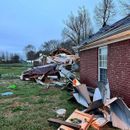Failure of Wall Without Sheathing
After the round of storms blew through the south east last night, I’d like to share an update with everyone that relates back to the QA spotlight discussing the sheathingless walls:
The storms blew through northern Alabama around 9:30 in my area, just to the west of Huntsville. The tornado sirens starting sounding about 9:40, as we headed down to the storm shelter. It was fairly routine, as it has been for some while now – now that the wife and kids are all familiar with the routine.
Luckily there wasn’t one in our direct path, but just a few miles north of us there was a small touchdown that damaged a few homes. No lives lost, just property damage.
Here’s a picture of the house. It’s sheathed in Styrofoam along that shear(less) wall. The house is a total loss, whereas it probably would not have been, had it been fully sheathed, and the roof secured with modern fastening methods and hardware.
The difference in cost along that wall is roughly -$50, at current prices. It’s cheaper right now to build a fully sheathed house, than one sheathed with 1″ rigid insulation. At pandemic highs, it would have cost perhaps $200 more to sheath that wall.
GBA Detail Library
A collection of one thousand construction details organized by climate and house part










Replies
Agreed. It is sort of cool to see those tall trees all standing when the house isn't. This suggests that the wind velocity was around 100 mph. Any well built house should be able to take that. The cost for this sort of wind upgrade seems small by comparison to the cost of replacement. Not to mention the risk of personal injury. Sheesh.
How were the walls braced? Let in wood or metal diagonals?
I can't really say, to be sure. I wasn't on site, it was passed on to me with little detail other than what was observed from outside the building.
Kyle,
There will always be building failures, but it's heartbreaking when they are the result of stupid decisions, deliberate or not. More than fifty thousand casualties in the recent Turkish earthquake. Seventy in the Grenfell fire.
Assuming the homeowners bought the house already built and had no particular knowledge in construction practices, they probably, and reasonably, assumed they had a typically resilient home.
This is what bothers me so much. It's uninformed consumers who pay the price of these decisions, while the builders walk away with the profits.
Factor in under-funded building departments which can't adequately inspect new construction and we're looking at "third world" style corruption as well.
That's the bummer! It's not even the primary residents who often have to pay the price.
Tornados energy is often very focused and when they cut thru production subdivisions where all the homes are built the same way we often see mostly undamaged home next door to total obliteration.
I agree that brick veneer with ply wood sheeting will survive better than vinyl siding over Styrofoam.
In tornado alley your odds are less than 1 in 4 million of getting hit in any given year so spending tens of thousands of dollars to maybe limit the damage may not be a good investment.
If you take a direct hit almost no structure will survive.
Walta
I agree, short of something very strong it's doubtful that any building would survive a direct hit.
What you see here is a 'pretty high wind', meaning it wasn't really even the tornado that did the damage. That house would have been hosed well before a tornado even got close!
I would have expected at least some shear panels every so often along that wall. I'm not even a fan of the diagonal steel bracing, even though code allows it. Panel sheathed walls are always going to be stronger, due to the solid panel and the many connecting points from all the nails. So-called "hurricane clips" and similar methods of fastening things around the top and bottom plates also make a big difference in wind survival of stick frame structures.
You really don't get into huge additional costs until you start building to survive "overpressure". I've been involved in a few (not many) projects built that way that house critical infrastructure, and they get *very* expensive. They are usually built to a spec for around 5PSI overpressure, and the walls are reinforced concrete. I can't see building a house that way though.
BTW, a lot of the problems with the third world and earthquakes is due to bad concrete mixes, insufficient rebar, and also poor connections between structural elements. The concrete mix is often due to corruption and corner cutting. My wife is a survivor of the earthquake in Gyumri in Armenia, and remembers when her family's 8th floor apartment was magically a 1st floor apartment when that quake hit. That city was nearly completely destroyed, and the cause of a lot of the damage was found found to be bad concrete mixes due to corrupt builders stretching materials to pocket some extra change. Stupid decisions with very, very bad consequences.
On the plus side, I saw a contractor on a recent project fail an open ceiling inspection in a commercial building becuase new fire retardant wasn't applied to parts of the steel structure where hangers were installed to support cables and pipes. While the red tag from the inspector slowed the project down a bit, it was good to see the inspectors really were paying attention to the details!
Bill